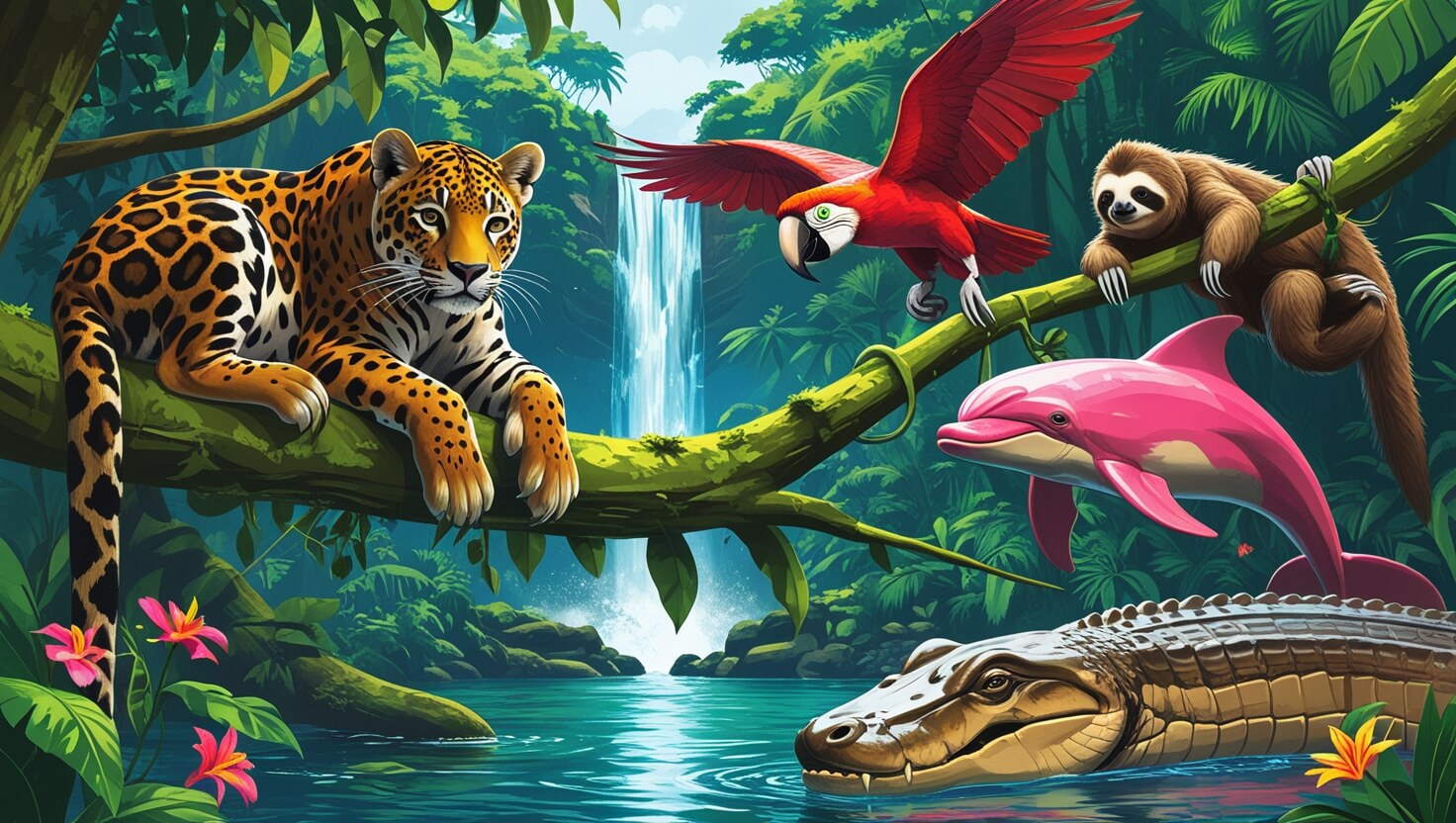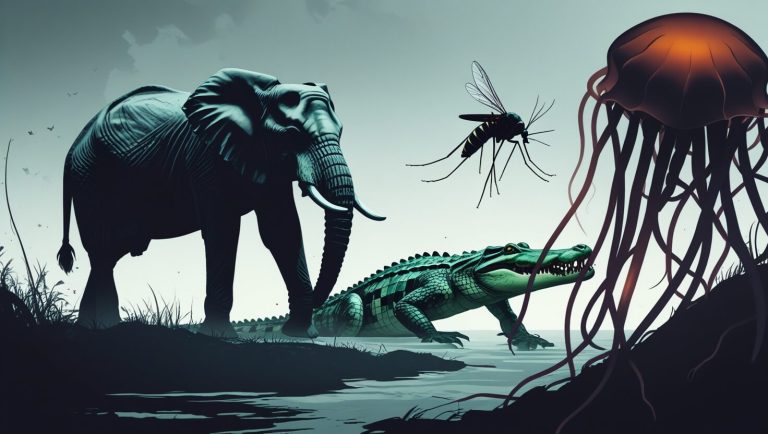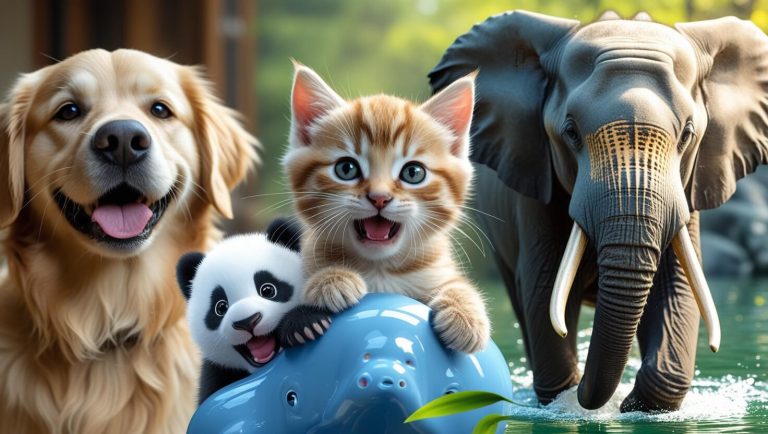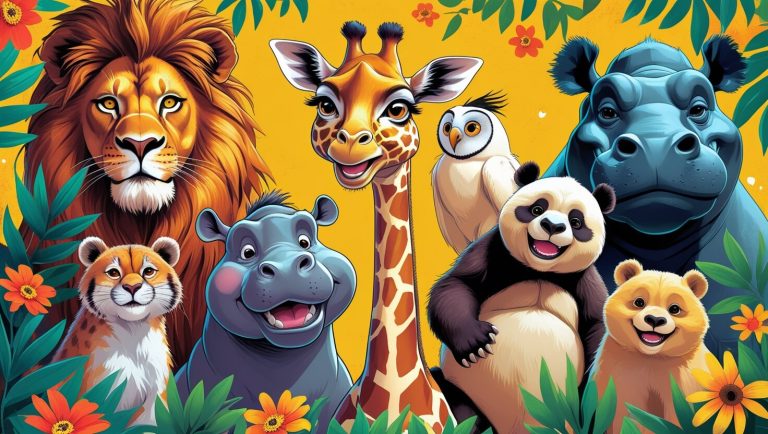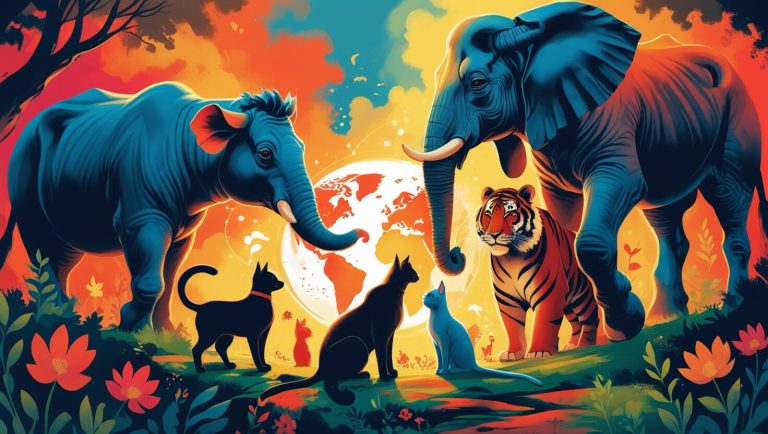Top 10 Animals Amazon Rainforest : The Ultimate List
The Amazon Rainforest is like a giant, living, breathing treasure chest. It’s the largest tropical rainforest on our planet, covering much of northwestern Brazil and extending into Colombia, Peru, and other South American countries. This incredible ecosystem is home to an estimated 10% of all known animal species on Earth. That means in this one jungle, you can find more types of animals than anywhere else!
From the mighty jaguar to the tiny poison dart frog, every creature plays a special part in keeping the Amazon healthy. Today, we’re going on a virtual adventure to meet ten of the most fascinating, beautiful, and important animals that call this rainforest home. Get ready to be amazed!

Top 10 Animals Amazon Rainforest
1. The Jaguar
The jaguar is the king of the Amazon jungle. This magnificent big cat is the largest cat in the Americas and the top predator in the rainforest. Unlike many other cats, jaguars are not afraid of water. They are excellent swimmers and often hunt for fish, turtles, or even caimans (a type of alligator) in rivers and streams.
Jaguars have a beautiful yellow-orange coat covered in dark spots called rosettes, which are like little roses that help them hide in the dappled light of the forest floor. Their most famous feature is their incredibly powerful bite. They can pierce straight through the skull of their prey, making them one of the strongest biters in the animal world.
Sadly, jaguars are listed as “Near Threatened” because they are losing their homes due to deforestation and are sometimes hunted by people. Protecting the Amazon means protecting the home of this majestic animal.
Fun Fact: Jaguars have the strongest bite of any big cat. They can even crush turtle shells!
Where to Find Them: Near rivers, swamps, and dense forests.
Why They’re Special: Jaguars are a symbol of power in many Amazon cultures.
2. The Amazon River Dolphin
Imagine a dolphin, but it lives in fresh river water and can be pink! The Amazon River Dolphin, also known as the Boto, is a truly magical creature. These dolphins are not the grey you see in the ocean; they can be shades of pink, or a mix of pink and grey. Scientists believe the pink color comes from scars and their age.
They have long beaks perfect for snatching fish from the flooded forest floors and are very flexible, able to turn their heads 90 degrees. This helps them navigate through tangled tree roots and underwater plants.
In local folklore, the Boto is thought to have magical powers. Stories say it can turn into a handsome man and come ashore at night! While that’s just a story, the real magic is in seeing one of these gentle, intelligent creatures swimming in the river. They are endangered due to pollution, dams, and getting accidentally caught in fishing nets.
Fun Fact: Pink dolphins can turn their heads 180 degrees, which helps them swim through tight spots.
Where to Find Them: Amazon and Orinoco river systems.
Why They’re Special: Local legends say pink dolphins can turn into humans at night!
3. The Scarlet Macaw
If a rainbow were a bird, it would be the Scarlet Macaw. This is one of the most recognizable birds in the world, with its brilliant red feathers, bright yellow and blue wings, and a strong, curved beak. They are a type of large parrot that lives high in the canopy (the top layer) of the rainforest.
You often hear them before you see them! Scarlet Macaws are very loud, using their squawks and screams to talk to each other across the vast forest. They mate for life and can often be seen flying in pairs. Their powerful beaks are perfect for cracking open hard nuts and seeds, which helps to spread those seeds and grow new trees. They are a vital part of the forest’s health.
Fun Fact: Scarlet macaws mate for life, so you’ll often see them flying in pairs.
Where to Find Them: High in the rainforest canopy (treetops).
Why They’re Special: Their bright colors make the Amazon look like a living rainbow.
4. The Poison Dart Frog
Don’t let their small size and beautiful colors fool you—this tiny frog is one of the most poisonous animals on Earth. Poison dart frogs are famous for their vibrant skin, which can be bright blue, yellow, red, or green. These colors aren’t for show; they are a warning to predators that says, “Don’t eat me, I’m toxic!”
Their skin contains powerful toxins that can paralyze or even kill an enemy. Interestingly, the frogs get this poison from their diet of ants, mites, and termites. Indigenous people of the Amazon used to rub their blowdart tips on the frogs’ skin to make their darts poisonous for hunting, which is how they got their name.
Despite their danger, they are dedicated parents, often carrying their tadpoles on their backs to pools of water.
Fun Fact: The brighter the frog, the more poisonous it is.
Where to Find Them: On the forest floor or near streams.
Why They’re Special: Their colors warn predators to stay away.
5. The Green Anaconda
The Green Anaconda is the heaviest snake in the world and one of the longest. This massive reptile is a master of the Amazon’s rivers and swamps. It has eyes and nostrils on top of its head, allowing it to see and breathe while almost completely submerged underwater, waiting for prey.
Anacondas are not venomous. Instead, they are constrictors. This means they wrap their huge, powerful bodies around their prey and squeeze until the animal can no longer breathe. Then, they swallow it whole. They can eat large animals like capybaras, deer, and even caimans. While stories about them eating people are mostly myths, they are still incredibly impressive and powerful predators.
Fun Fact: Anacondas can go months without eating after a big meal.
Where to Find Them: In rivers, swamps, and marshes.
Why They’re Special: They’re one of the most powerful predators in the Amazon.
6. The Capybara
Meet the capybara, the world’s largest rodent! Imagine a guinea pig, but one that can weigh over 100 pounds. These gentle giants are perfectly built for life in the Amazon. They have slightly webbed feet, which make them great swimmers. They often escape from predators like jaguars by diving into the water and hiding.
Capybaras are very social animals and live in groups of 10 to 20. They are herbivores, meaning they only eat plants and grasses. They are surprisingly calm and are often seen relaxing on riverbanks or even letting birds sit on their backs! Their peaceful nature makes them a favorite among many rainforest animals.
7. The Glass Frog
The glass frog is one of the most bizarre and fascinating creatures in the Amazon. Why is it called a glass frog? Because you can see right through its skin! The skin on its belly is completely transparent, so you can see its heart, liver, and digestive system working.
This see-through trick is a brilliant form of camouflage. When a glass frog sits on a leaf, its transparent body helps it blend in, making it very hard for predators to spot it. They are mostly active at night (nocturnal) and live in trees near streams. They are a perfect example of how weird and wonderful evolution in the rainforest can be.
8. The Black Caiman
The Black Caiman is the largest predator in the Amazon River ecosystem. It’s a massive, black-skinned relative of the alligator that can grow over 16 feet long. As an apex predator, it sits at the very top of the food chain, helping to control the populations of fish, birds, and mammals like capybaras.
They are mostly nocturnal hunters, using the cover of darkness to sneak up on their prey. Their eyes have a special layer that makes them glow red in the dark when a light shines on them. Once hunted nearly to extinction for their skin, their numbers are slowly recovering thanks to conservation efforts, showing how important it is to protect these ancient reptiles.
9. The Jesus Lizard
This lizard has a name that tells you exactly what it’s famous for: the Jesus Lizard. Why? Because it can literally run on water! When threatened by a predator, this amazing lizard can jump onto the surface of the water and run on its two back legs for a short distance.
They can do this because they have special fringes on their toes that create air pockets and increase surface area, allowing them to slap the water and stay above it. They are also beautiful lizards, with males having bright green color and fancy crests on their heads, backs, and tails, earning them the other name: the Plumed Basilisk.
10. The Bullet Ant
Last on our list, but certainly not least in terms of impact, is the Bullet Ant. This insect has the most painful sting of any insect in the world, according to scientists. The pain is described as pure, intense, blinding pain that can last for up to 24 hours. It’s said to feel like being shot, which is where its name comes from.
These large ants live in colonies at the bases of trees. They are predators, but their sting is mainly for defense. Surprisingly, some indigenous tribes have a coming-of-age ritual where a young man must wear a glove filled with bullet ants for several minutes to prove his courage and transition into manhood. It’s a powerful reminder of the deep connection between the people of the Amazon and its wildlife.
Why the Amazon Rainforest is a Wildlife Haven
The Amazon Rainforest is the largest tropical rainforest in the world, covering over 5.5 million square kilometers. Its dense canopy, warm climate, and abundant water sources create the perfect environment for countless species to thrive. Scientists estimate that the Amazon is home to 10% of the world’s known species, making it a hotspot for biodiversity. From tiny insects to massive mammals, the animals here have adapted in incredible ways to survive in this lush, complex ecosystem.
Why These Animals Matter: The Bigger Picture
Every animal on this list, from the giant jaguar to the tiny bullet ant, is a thread in the beautiful tapestry of the Amazon Rainforest. They all have a job to do:
- Predators like the jaguar and black caiman keep other animal populations healthy and in balance.
- Herbivores like the capybara help shape the plant life by what they eat.
- Birds like the macaw help spread seeds to grow new trees.
- Even the poison dart frog shows the incredible connections in the food web.
This ecosystem doesn’t just benefit the animals that live there. The Amazon Rainforest produces about 20% of the world’s oxygen and stores massive amounts of carbon dioxide, helping to regulate the entire planet’s climate. It is often called the “Lungs of the Earth.”
When we protect the Amazon and its amazing animals, we are ultimately protecting ourselves and our future.
Frequently Asked Questions (Q&A)
u003cstrongu003eWhat is the u003ca href=u0022https://animalverse.info/top-10-most-dangerous-animals/u0022u003emost dangerous animalu003c/au003e in the Amazon Rainforest?u003c/strongu003e
This depends on what you mean by u0022dangerous.u0022 The u003cstrongu003ebullet antu003c/strongu003e has the most painful sting. The u003cstrongu003ejaguaru003c/strongu003e is the most powerful predator. The u003cstrongu003epoison dart frogu003c/strongu003e has deadly toxins. However, many experts would say the u003cstrongu003emosquitou003c/strongu003e is the most u003ca href=u0022https://animalverse.info/top-10-animals-that-kill-humans/u0022u003edangerous to humansu003c/au003e because it can carry diseases like malaria. But remember, most animals are not interested in humans and will only attack if they feel threatened.
u003cstrongu003eAre there any animals in the Amazon that are only found there?u003c/strongu003e
Yes! The Amazon is full of u003cstrongu003eendemic speciesu003c/strongu003e, which are animals that don’t live anywhere else on Earth. Good examples from our list are the u003cstrongu003eAmazon River Dolphin (Boto)u003c/strongu003e and the u003cstrongu003eGlass Frogu003c/strongu003e. Many other species of monkeys, birds, and insects are also endemic to this specific rainforest.
u003cstrongu003eIs it safe to visit the Amazon Rainforest to see these animals?u003c/strongu003e
Yes, it can be very safe if you go with a reputable tour guide. Knowledgeable guides know how to keep you safe from any potential dangers and where to find wildlife without disturbing it. They teach you to respect the animals and their home. Never try to explore the deep rainforest alone.
u003cstrongu003eWhat is the biggest threat to these Amazon animals?u003c/strongu003e
The single biggest threat is u003cstrongu003edeforestationu003c/strongu003e—the cutting down and burning of trees to clear land for farming, ranching, and mining. This destroys the homes of these animals, breaks up their habitats, and can lead to them becoming endangered or extinct. Other threats include pollution, climate change, and illegal hunting.
u003cstrongu003eHow can I help protect the Amazon Rainforest and its animals from my home?u003c/strongu003e
u003cbru003eu003cstrongu003eLearn and share:u003c/strongu003e Tell your friends and family about how amazing the Amazon is.u003cbru003eu003cbru003eu003cstrongu003eSupport responsible companies:u003c/strongu003e Try to buy products from companies that are committed to not using ingredients that lead to deforestation (like some unsustainable palm oil or soy).u003cbru003eu003cbru003eu003cstrongu003eDonate:u003c/strongu003e You can donate to legitimate organizations that work to protect the rainforest, such as the World Wildlife Fund (WWF) or the Amazon Conservation Association.u003cbru003eu003cbru003eu003cstrongu003eReduce, Reuse, Recycle:u003c/strongu003e Using less paper and wood products can help reduce the demand for cutting down trees.u003cbru003e
Conclusion:
A World Worth Saving the Amazon Rainforest is a treasure trove of life, and its animals are a testament to nature’s creativity. From the stealthy jaguar to the tiny poison dart frog, each creature plays a role in this complex ecosystem.
By learning about these animals and supporting conservation efforts, we can help ensure the Amazon remains a vibrant home for wildlife for generations to come. So, next time you hear about the Amazon, picture these incredible creatures and the jungle they call home!
judi bola situs toto link slot situs toto link slot link slot monperatoto

Rony Junior is a lifelong animal lover who’s happiest with muddy paws on the couch and fur on their clothes. From curious cats to loyal dogs and everything in between, they write about the joy, challenges, and quirks of living alongside animals. When not blogging, you can find them at the local shelter, giving belly rubs and making new four-legged friends.

